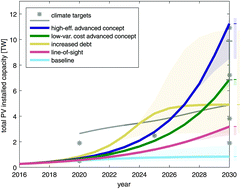Economically sustainable scaling of photovoltaics to meet climate targets†
Abstract
To meet climate targets, power generation capacity from photovoltaics (PV) in 2030 will have to be much greater than is predicted from either steady state growth using today's manufacturing capacity or industry roadmaps. Analysis of whether current technology can scale, in an economically sustainable way, to sufficient levels to meet these targets has not yet been undertaken, nor have tools to perform this analysis been presented. Here, we use bottom-up cost modeling to predict cumulative capacity as a function of technological and economic variables. We find that today’s technology falls short in two ways: profits are too small relative to upfront factory costs to grow manufacturing capacity rapidly enough to meet climate targets, and costs are too high to generate enough demand to meet climate targets. We show that decreasing the capital intensity (capex) of PV manufacturing to increase manufacturing capacity and effectively reducing cost (e.g., through higher efficiency) to increase demand are the most effective and least risky ways to address these barriers to scale. We also assess the effects of variations in demand due to hard-to-predict factors, like public policy, on the necessary reductions in cost. Finally, we review examples of redundant technology pathways for crystalline silicon PV to achieve the necessary innovations in capex, performance, and price.


 Please wait while we load your content...
Please wait while we load your content...